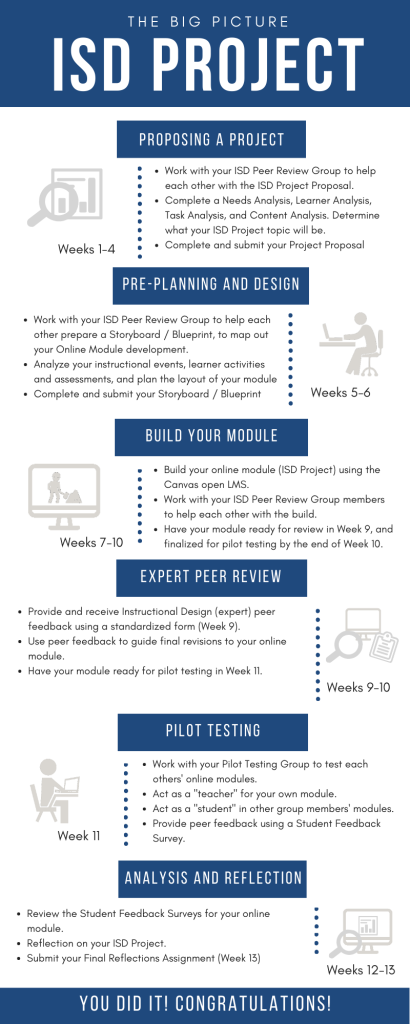Introduction
Welcome
Welcome! If you are reading this book, you probably fall into one of three categories:
- You are participating in one of my instructional design and educational technology courses.
- You are an instructor looking for a companion resource for an instructional design and educational technology course.
- You are interested in learning how to design, develop, and test your own instructional design processes.
In either case, you have come to the right place! But, before we get started, a little bit about me. The following video (Power, 2019) that I created using PowToon (2022) is one that I use as a personal introduction in all of my online courses.
Why Am I Sharing This Now?
Just like an in-person classroom, I would never begin the first day of a course by jumping right into the academics. I would greet my students at the door, introduce myself, and take some time to help everyone get to know each other. That’s part of my effort to humanize the online learning experience. I share my Instructor Welcome Video as a way to introduce myself, and inject some teacher and social presence before we get down to work. In some of my online instructional design courses, I then ask participants to create their own welcome videos. It’s a fun way to break away from the traditional “introduce yourself” discussion post. It also gets participants to break out of their comfort zones a bit with educational technology that they may or (likely) may not have much experience with – and to help them build their confidence with using digital tools before they embark on a larger, higher-stakes course project.
I take a deeper look at this idea in the chapter Adding a Human Touch to Online Learning, Right From the Start (based on my 2019 blog post), found in the Getting Started section of this book.
Why This Book?
This book has been developed based on a couple of instructional design for online teaching and learning courses that I have taught at different Canadian universities in recent years. In those courses, I focus on a project-based learning experience that walks participants through the first few weeks of an instructional design and development project. In a real-world context, the steps covered in these courses typically span the first six to eight weeks of designing and developing online courses as a contract instructional designer or as an in-house ID specialist. However, we take a full academic term (12-13 weeks) to work through the process, exploring the rationale and pragmatics of all of the steps involved with determining what needs to be developed, creating our initial design plans, developing a prototype of a selected portion of the larger ID project, collaborating with other instructional designers to get “expert feedback” on our works-in-progress, pilot testing our prototypes with a “live” student audience, reflecting on the expert and student feedback we receive, and determining how we can tweak our prototype designs before proceeding with the rest of the course development project.
I teach additional educational technology courses that focus more on the roles of instructional designers, the theories and models that guide instructional design decisions, and the practicalities of selecting appropriate digital tools, resources, learner activities, and assessment tools. Since there is much overlap between these topics and activities in my online learning development courses, I have also drawn from the resources shared in these educational technology courses to produce this everyday guide to designing, developing, and testing your own ID projects.
What to Expect
I have organized this book into six main sections. The first, Getting Started, includes a more detailed look at humanizing online learning by sharing an instructor welcome video, as well as a brief introduction to the ADDIE model of instructional design. The remaining sections are organized according to the five stages of the ADDIE model (Kurt, 2019), which guide the processes participants work through in my instructional design courses:
- Assess/Analysis
- Design
- Develop
- Implement
- Evaluate
While the primary focus of this book revolves around the aforementioned ISD pilot project, I have also included some discussions and resources for smaller scale projects like individual lesson and unit planning.
The ISD Project
If you are a participant in one of my instructional design for online teaching and learning courses – or if you are interested in following the same systematic processes to design and develop your own online courses – then this book is definitely for you! The following infographic created using Canva (2022) is adapted from one that I share with participants in those courses, outlining how the course will unfold and what they will need to do at each stage.

Designing Lesson Plans and Unit Plans
Perhaps you are not looking at developing a full online course right now. There’s nothing wrong with that! Many of the concepts, processes, and resources explored in this book will still be helpful to you. In particular, in the Design section, I have included explorations of my favorite lesson planning model – the BOPPPS template (Pattison & Day, 2006) – as well as an overview of an educational technology-infused unit planning project completed by participants in another one of my courses.
References
Canva (2022). About Canva: Empowering the world to design. https://www.canva.com/about/
Kurt, S. (2017, August 29). ADDIE Model: Instructional Design. [Web log post]. Educational Technology. https://educationaltechnology.net/the-addie-model-instructional-design/
Pattison, P., & Day, R., Eds. (2006). Instructional Skills Workshop Handbooks for Participants. The Instructional Skills Workshop International Advisory Committee, TAG, UBC
Power, R. (2019, January 22). Adding a Human Touch to Online Learning, Right From the Start. [Web log post]. Power Learning Solutions. https://www.powerlearningsolutions.com/blog/adding-a-human-touch-to-online-learning-right-from-the-start
Power, R. (2019, November 19). Hi There! Meet Rob Power. [YouTube video]. https://youtu.be/ff-6GtdX9xM
PowToon (2022). https://www.powtoon.com/
